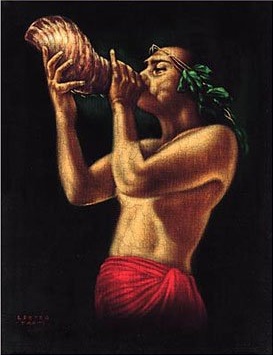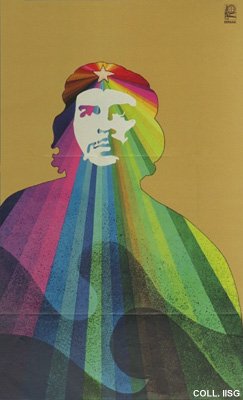Velvet paintings have a bad name, and most of them deserve it. Crude, mass-produced pictures of Elvis, JFK, and dogs playing pool are the norm. But velvet is a difficult medium to work with, and Edgar William Leeteg had a facility with it that approached genius. Inexpertly applied, paint will cake and clog the velvet nap. The black velvet dye can bleed even the brightest colors to muddy browns and dull, dirty grays. Leeteg knew black velvet like an astronomer knows the night sky. With an artist’s instinct, he painted each individual strand, adding thin layers of color one at a time. He used a limited palette—only seven colors and white—but created results so rich that one observer said that he “painted with light.”
Known to many as the American Gauguin, Leeteg (1904-1953) led a Jack Kerouac life, ghost-written by William Burroughs. An adventurer by nature, he fled civilization to lead a wild life in Tahiti. Even in a culture not known for its puritanism, he stood out, drinking, fighting, and wenching more than any six men. He once described himself as a “fornicating, gin-soaked dopehead.”

But his carousing was a calculated pose to promote his art, and the staggering quantity of paintings he left behind (an average of three a month for 20 years) suggests that he was as much a workaholic as an alcoholic. A butcher’s boy and the grandson of a graveyard sculptor in East Saint Louis, Leeteg picked cotton, herded cattle, and did factory work until he landed a job at 22 as a sign painter in Sacramento. When the Depression hit and the work ran out, Leeteg took a small inheritance and set sail for Tahiti with brushes stolen from the sign company and six mayonnaise jars full of paint. His first commissions—posters and lobby ads for theaters—barely put food on the table. He lived hand to mouth, restlessly experimenting with different painting surfaces, including wood and cloth. Finally, he hit on velvet—and struck gold. Leeteg circulated the story that his first velvet “canvas” came from a mortuary, suggesting a discovery born from desperation. But he knew velvet’s potential; in museum visits, he had seen Renaissance and Victorian velvet paintings. Velvet became the perfect medium through which to express Leeteg’s love of Tahiti’s sensual beauties—the natural light, the landscape, and especially the native women.
Paradise painted (Seattle Weekly)
Michael Snow still surprises
At the age of 76, Michael Snow, Toronto’s most celebrated artist, continues to astonish us with his inventions.
He recently unveiled his newest public art piece, a changing projection located on the exterior of the Pantages Hotel on Victoria St.
Q Your new work is unlike any other public art in Toronto. What are some of the scenes passers-by will see in The Windows Suite?
A One involves the top four “windows” (really flat plasma screens), which are widely separated.
You see a room like one in this hotel, with a bed. Two policemen appear, apparently looking for something. They wave a flashlight around, forward and horizontally, and the light flashes through to the other rooms (seen through the windows). They then appear in the other rooms, moving the flashlight.
We see one segment called “Red Tape” in which a man goes from window to window and sticks red tape across the glass diagonally to make an X. Then the whole thing is played backwards so that the tape comes off.
TheStar.com – Michael Snow still surprises
Cuban Posters
With a small rebel army, Fidel Castro seizes power in Cuba by the end of 1958. Although he tries to take an independent line, he must deal with significant Russian influence on the new regime. The socialist realist posters from the early years attest to this influence.
Around 1965, in a period of strained relations with the Soviet Union, the Cubans decide to develop styles more suitable to their own circumstances. A period of artistic freedom follows. The arts flourish, and there are lively international contacts. Talented Cuban artists start designing colourful, inventive posters of traditional subjects such as commemorations of the revolution or calls for more production. The Cuban leaders are portayed as cheerful and unconventional. Especially striking are the splendid posters issued by cultural organizations such as the ICAIC, the Cuban film institute. OSPAAAL, the organization for solidarity with the people of Africa, Asia, and Latin America, distributes its posters worldwide. Che Guevara’s portrait is transformed into an international symbol for romantic rebellion.

Heroic, idealized portraits like this one are made only from Che Guevara, and only after his death. Fidel Castro and the other leaders are deliberately portrayed as ordinary human beings.
The Chairman Smiles – Cuban Posters

